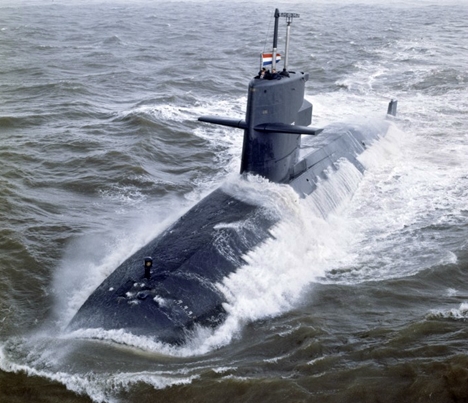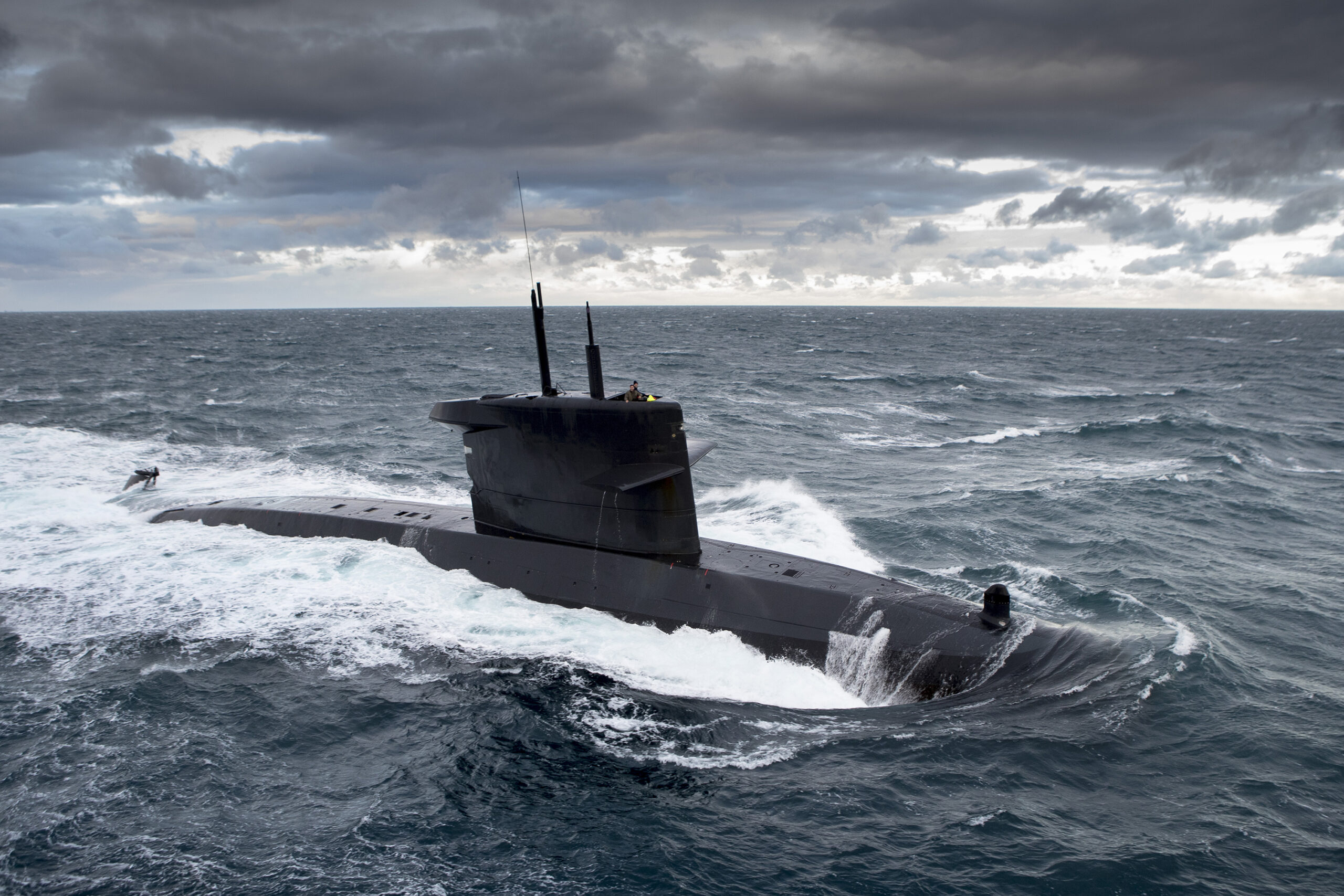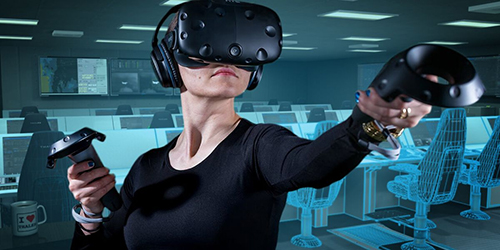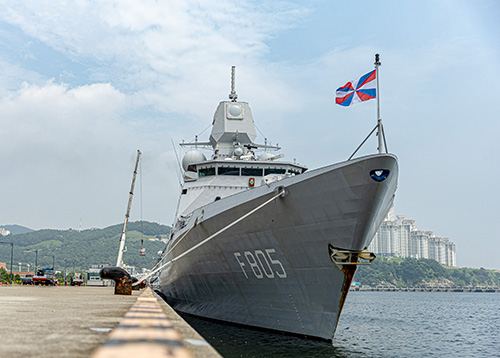Working together in combat 2.0
The basis in a conflict situation is working together, so that together you can achieve more than all separate on their own. Thanks to new technologies, there are many new opportunities in the field of cooperation and Thales is thinking about these new possibilities under the heading of ‘collaborative combat’.
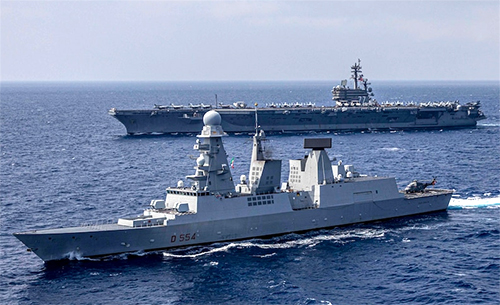
Nimitz-class aircraft carrier USS George H.W. Bush (CVN 77), back, sails alongside the Italian navy Orizzonte-class destroyer ITS Caio Duilio (D 554) during combined operations in the Adriatic Sea, Sept. 8, 2022. (Photo: Petty Officer 3rd Class Novalee Manzella/ US Navy)
Paul Rouffaer has worked in the Royal Netherlands Navy from 1977 to 2015 as an officer in the Electrotechnical Service (now merged into the Technical Service) and sailed on numerous ships. Rouffaer worked in the US on the integration of ESSM and APAR, and later became the head of the APAR, Sirius and Theater Ballistic Missile Defense project teams in the Navy’s Materiel Directorate, and was later responsible for the SMART-L testing in 2006 at Hawaii.
Rouffaer has now been working at Thales for some time now and Naviesworldwide.com talked with him about ‘collaborative combat’, a concept that is one of Thales’ focus areas.
“As long as warfare has taken place, we have always been engaged in collaborative combat,” says Rouffaer. “Technological developments have now given it a different turn and you can speak of a breakthrough.”
What exactly is it? “Collaborative combat is a fully integrated combat command architecture, or network, that consists of: people, i.e. sailors on board and soldiers in the field, of platforms, i.e. ships, tanks, aircraft, and of weapons and sensors. All this works together in real time, all these elements are connected in full synergy. Strategically, operationally, tactically and in all domains: sea, land, air and space. This is the ultimate network, where everything involved in warfare is interconnected. That’s the concept.”
A concept, because in practice this is far from the case. Although movies and games suggest otherwise, in reality many steps still need to be taken before that ultimate integration has taken place. There are still plenty of naval ships in the world where even the systems on board don’t work together, let alone one ship with other ships or with units in the air or on land.
Thanks to new technologies such as better and more secure connections, big data and artificial intelligence, according to Rouffaer, a new era is dawning in the field of collaboration.

Italian FREMM frigate ITS Antonio Marceglia, Dutch frigate HNLMS De Zeven Provinciën and Arleigh Burke class desproyer USS Roosevelt during Formidable Shield in May 2021. (Photo: US Navy)
Information-focussed action
As stated in Defensievisie 2035, a Dutch MOD publication that describes how the Dutch armed forces are preparing for the future, information is crucial for success in a future conflict. Rouffaer: “Information dominance is essential in order not not escalate a conflict and, if it escalates, to make sure that you win the battle. Collaborative combat means that countries and armed forces have a complete and accurate picture of the tactical situation. The image that is shared between all relevant actors in the network. As a result, by sharing information, you get high-quality information and you can also make better decisions, based on the right information. This in turn leads to more effective and efficient operations. You can act faster and more robustly. You have more options and can react better when plans don’t go as planned and that is almost by definition the case.”
“This allows you to speed up your processes and eliminate the opponent more efficiently and effectively. This is also much faster, with our own resources. Combat capacity is increased and there are fewer misunderstandings, for instance concerning friendly fire. You also have a greater effectiveness of your weapons. Because you have information dominance, you can also react proportionally , so that a situation gets unnecessarily out of hand. You ensure a more manageable performance, which in turn is related to more efficient use of the resources you have.”
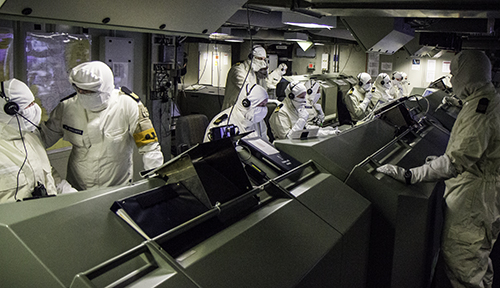
The opsroom onboard a Dutch Air Warfare and Command Frigate. (Photo: Jaime Karremann/ Marineschepen.nl)
Classic example
Rouffaer cites the exercise Formidable Shield as “a very simple, clear and classic example” of collaborative combat. During the most recent edition of that exercise, a ballistic target was launched from Scotland to return to earth via space towards the Atlantic Ocean. The Dutch Air Defence and Command Frigate (LCF) HNLMS De Zeven Provinciën had to detect the target with the new SMART-L MM/N from Thales. “Absolutely a classic example”, continues Rouffaer. “The LCF detected the target, the American ship USS Paul Ignatius did not see the target, but had already launched a missile based on the information from the De Zeven Provinciën. That information had already passed through all parties involved before the launch decision was taken. Of course it has been a technological tour de force, but this was still a relatively simple scenario.”
Another example. Rouffaer: “There are also discussions in Thales about the possibilities of having one ship within a maritime task group take over the control of the radar systems on other ships. This ship can then concentrate the detection capacity of radars from other ships on certain sectors. A step further is that radars outside the context can also be adopted. In a number of countries, this is being considered.”
“The next step is for one ship in a squadron to use the radar and weapons of another ship. You can do the entire engagement planning with collaborative combat in such a way that multiple ships do not fight the same target, or they do, but according to one plan.”
“This is not only at sea, it also works on land. Two Marines are somewhere in the field, with a camera on their helmets. They look at the same target from different positions. With a kind of cross bearing you immediately have a position and then a tank that is a bit further away can put a grenade on that spot at once, completely automatically without the tank itself having seen the target.”
“With the introduction of unmanned autonomous systems, flying, sailing or underwater, there will be a lot more information that can be shared with other units.”
Challenges
The benefits are clear and a concept based on connections sounds very feasible in our current society that relies more and more on the internet Yet the challenges are enormous. When the Norwegian frigate Helge Ingstad was hit by a large ship in 2018 and water poured in, the crew in the Technical Centre received 564 different alarm messages on their screens in no time. The system gave no priority. In the end, wrong decisions were made and the ship sank.
“The physical world and reality are always more unruly than the most beautiful laboratory,” says Rouffaer. “Processing the enormous amount of data is a challenge. If you give everyone everything, people quickly become overloaded. That’s where big data and Artificial Intelligence come in. Your systems must help to determine which information is relevant, and must filter to avoid overload. There are also methods where you can subscribe to some kind of information, rather than getting an unlimited amount and having to figure it out for yourself.”
“The question is also what information are you going to exchange, because the more information you exchange, the larger the bandwidth you need. The larger the bandwidth, the higher the frequency, the higher the frequency, the shorter the range. Those are things that come into play. Do we want to use satellites? Yes of course. But if satellites are being shot out of space, especially communications satellites, and it’s not unlikely that this will happen in a serious conflict, then you’ll have to do it another way. You will have to build in a kind of robustness and redundancy, even if satellites fail.”
“The user-friendliness of the systems is important. How do you ensure that people can deal with it in a good way? Then there are of course the ethical and legal aspects that you have to consider. Which decisions do you make with humans and which with an algorithm? There are quite a few.”
And then there are even more challenges. “Network latency is also a very important one. You need to get information in a timely manner. If you receive information from 10 minutes ago, it may be too late. Or even counterproductive; sometimes it is better not to get information at all than information that is too late.”
More connections means greater vulnerability. Not only the flagship wants to control the radars and weapons of other ships, the opponent wants to do the same. “That is precisely the vulnerability of collaborative combat, because there are countless connections. We will have to come up with solutions for that so that they cannot be hacked. And if there is a hacking attempt, that it is detected in time and alternative connections can be established.”
Some navies actually work less with GPS, navigating more with resources that cannot be hacked. “There are more examples,” says Rouffaer. “You can also solve some issues by applying new technologies. But you can hardly escape collaborative combat. It is a fact that with a radar with a certain frequency you can only see up to a certain distance. No matter how much power you put into a radar, you can’t see below the radar horizon. Then, in view of the threat of faster and faster missiles, you will really do something about it in a collaborative concept, where you get the information from outside. You will have to communicate with other units that operate at a great distance. That is inevitable. That you do things like navigation differently, for example based on seabed contours, and keep it local, that’s great. But if you strive for synergy between different units, they will have to talk to each other and that doesn’t happen by cable.”
Command structure
If data is going to be shared in a different way, this may mean that other units or other people will also have or want to have control over actions or operations. What are the changes in the command structure? “That’s still a bit too early,” replies Rouffaer. “It is one of those things that will have to be arranged particularly well in the coming period. But that’s not up to Thales of course. Politicians and the military must decide on this.”
Nevertheless, Rouffaer is willing to give his vision: “You can certainly make decisions at a lower level. The choice that may be made, may then deviate from a decision taken centrally. Because of the amount of data, it could be more centralized. That depends on the philosophy of the user; we, the industry, cannot answer that. For instance one navy may have a more centralized orientation and another may have opted for a federal approach, because that gives you more resilience. You can be disturbed less and it is more robust in a way. If you arrange it centrally and things go wrong there, everything will go wrong.”
“Of course, Artificial Intelligence also plays an important role here and the pace of the battle. To what extent will AI take over the decisions? Do humans make the decision with the support of AI? Or do we go so far as to have those decisions taken fully by AI? That is not an easy discussion. But the pace of the battle picks up. At a certain point you can ask the question, do you even have the time to involve people in decision-making processes?”
Next steps
What is needed to be able to take the next steps? “What we need is that we develop the broadest possible standards that enable the phased introduction of this architecture. You can realize it without technical breakthroughs. Those technical developments will come or are already there.”
“Collaborative combat will make use of clouds that already exist. But how do you ensure that the information in those clouds is safe? This is mainly a matter of making agreements and building and continuing in a structured manner. And of course you should test it. Start small, test, implement and expand. Step by step.”
Starting small is important, says Rouffaer. “As the number of actors in a network increases, the number of combinations explodes. It can become incredibly complex in a short period of time. Presumably you cannot handle that complexity in one go, and therefore you cannot set up a system in one go. What is therefore important is that good interface definitions are agreed in advance, and we move to an open architecture, so that you can start on a smaller scale and continue to expand.”
This process has already started, says Rouffaer. “But defining all these standards is definitely something that should be given more priority and urgency.”
NATO
Many different companies, organizations and governments will be involved in this concept. According to Rouffaer, NATO has an important role to play. “NATO is in any case the big driver and is very much aware of the enormous military acceleration that both Russia and China are going through. We will have to force a breakthrough in our capabilities to face that threat. NATO is made up of nations and generally does not buy or develop systems itself.”
“What NATO can do is define standards. That is a very important role. There is even a special department for standardization in NATO. They manage it, but that standardization must be driven from the operational angle. NATO is also working on it and trying to get countries and industries to establish standards. The area leading the way is underwater systems. That’s where a huge effort is now made on communication standards in order to be able to task, give orders and control under water. NATO is keeping the pressure on here.”
Need
Despite all the challenges and obstacles that have to be overcome, Rouffaer sees no other way forward. Naturally, this concept is also being worked on in less friendly countries. Rouffaer: “Recently it has become very clear that there is a need to react faster and more intelligently than the potential opponents. We will really all have to move towards a collaborative combat-like architecture in the West. You may call it collaborative combat, or use the US name: advanced battle management system. It doesn’t matter what you call it, but the idea is the same. And Thales can of course make a substantial contribution.”
This is a sponsored article. With a sponsored article, a client chooses the subject of the article. Thales paid Marineschepen.nl to write this article on this topic, but Thales had no influence on the journalistic content.

